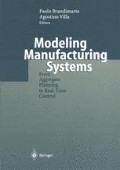Abstract
The hierarchical approach to production planning is classically used to handle the organization and logistics in complex production systems. It distinguishes several decision levels using different descriptions of the production process. The upperlevel planning horizon is relatively long, and, since the number of time intervals (or buckets) of this horizon is restricted by computational limitations, these buckets are long compared with production cycle times. At this time scale, discrete flows in manufacturing plants can be approximated by continuous flows describing production processes in an aggregated and simplified way. Product flows are generally associated with families of products (Bitran, Tirupati 1993 [4]). In the discrete-time framework used in this study, these flows generate, over each time bucket, important amounts of products, which can be approximately represented by continuous variables. The optimal planned outputs are computed on the basis of forecasted demands and aggregate resource constraints. The results obtained at the aggregate planning level then have to be disaggregated in time and detailed by products and items, taking into account some basic constraints originating from operational levels. As the time horizon is chosen smaller, hard constraints and conflicts increase and continuous variables are less appropriate for describing real phenomena (Agnetis et al. [2]). Other models, of the discrete event type, are needed to schedule production, supplies and sales. Heterogeneous models are obviously hard to combine, and much research effort have been devoted to constructing integrated planning and scheduling schemes (see e.g. Gershwin 1987 [9], Dauzère-Péres, Lasserre 1994 [7]).
Access this chapter
Tax calculation will be finalised at checkout
Purchases are for personal use only
Preview
Unable to display preview. Download preview PDF.
References
A.F. Jr. Veinott. Minimum concave-cost solution of Leontief substitution mod-. els of multi-facility inventory systems. Operations Research, Vol.17, No 2, pp.262–291, 1969.
A. Agnetis, C. Arbib, and M. Lucertini. The combinatorial approach to flow management in FMS. In Optimization Models and Concepts in ProductionManagement, P. Brandimarte and A. Villa Eds., pages 107–152. Gordon and Breach Publishers, 1995.
S. Axsater. Aggregation of product data for hierarchical production planning. Operations Research1981.
G.R. Bitran and D. Tirupati. Hierarchical production planning. In Handbooks in Operations Research and Management Science Vol. 4 S.C. Graves A.H.G. Rinnooy Kan P.H. Zipkin Eds.pages 523–568. North-Holland, 1993.
P. Brandimarte, W. I kovitch, and A. Villa. Factory level aggregate scheduling: Bridging the gap between optimized scheduling and real time control. In Optimization Models and Concepts in Production Management P. Brandimarte and A. Villa Eds.pages 187–212. Gordon and Breach Publishers, 1995.
D.W. Clarke, C. Mohtadi, and P.S. Tuffs. Generalized predictive control, parts 1 and 2. Automatica Vol.23, No.2 pp.137–1601987.
S. Dauzère-Péres and J.B. Lasserre. An integrated approach in production planning and scheduling. Springer-Verlag, 1994.
D.W. Fogarty and T.R. Hoffmann. Production and inventory management. South-Western Publishing Company, 1983.
S.B. Gershwin. A hierarchical framework for manufacturing system scheduling. In Proceedings of the IEEE Conf. on Decision and Control, Los Angeles, 1987.
R.W. Grubbström and A. Molinder. Further theoretical considerations on the relationship between mrp, input-output analysis and multi-echelon inventory systems. Intl. J. Production Economics, Vol. 35, pp. 299–311, 1994.
J.C. Hennet. A modelling technique for production planning. Manufacturing Systems Vol.21, No.2 pp.107–1121992.
J.C. Hennet and I. Barthès. Closed-loop planning of multi-level production under resource constraints. In Proceedings of the IFAC Symposium INCOM’98 Nancy (France)1998.
J.C. Hennet and M. Vassilaki. Modélisation et gestion de systèmes de production avec stockages. RAI RO- APII, Vol. 21, pp.3–16, 1987.
C. Merce J. Erschler, G. Fontan. Consistency of the disaggregation process in hierarchical planning. Operations Research, Vol. 14, no. 3, 1985.
K. Jensen and G. Rozenberg Eds. High-level Petri Nets. Springer-Verlag, 1991.
J.B. Lasserre and C. Bes. Infinite horizon non stationary stochastic optimal control problem: A planning horizon result. IEEE Trans. Automatic Control Vol. 29, No.9 pp. 836–8371984.
J.H. Lee, M. Morari, and C.E. Garcia. State-space interpretation of model predictive control. Automatica Vol. 30, No.4 pp. 707–7171994.
W.W. Leontief. Structure of the American Economy 1919–1939. Oxford University Press, New-York, 1951.
J. Maes and L.N. Van Wassenhove. A simple heuristic for multi-item single level capacitated lotsizing problems. Operations Research Letters, Vol.4, No.6, pp.265–273., 1986.
C. Merce, G. Hetreux, and G. Fontan. Planification agrégée et planification détaillée. In Concepts et Outils pour les Systèmes de Production, J.-C. Hennet Ed., pages 23–44. Cepadues, 1997.
M. Salomon. Deterministic Lotsizing Models for Production Planning. LNEMS Vol. 35, Springer Verlag, Berlin, 1991.
M. Vassilaki and J.C. Hennet. Modelling and safety stock analysis in a multiproduct industrial process. In Proceedings of the IMACS-IFAC Symposium, Lille, Prance, pp.439–44 2, 1986.
A. Vazsonyi. The use of mathematics in production and inventory control. Management Science, Vol. 1, No. 1 pp.70–85, 1955.
Author information
Authors and Affiliations
Editor information
Editors and Affiliations
Rights and permissions
Copyright information
© 1999 Springer-Verlag Berlin Heidelberg
About this chapter
Cite this chapter
Hennet, JC. (1999). From the Aggregate Plan to Lot-Sizing in Multi-level Production Planning. In: Brandimarte, P., Villa, A. (eds) Modeling Manufacturing Systems. Springer, Berlin, Heidelberg. https://doi.org/10.1007/978-3-662-03853-6_2
Download citation
DOI: https://doi.org/10.1007/978-3-662-03853-6_2
Publisher Name: Springer, Berlin, Heidelberg
Print ISBN: 978-3-642-08483-6
Online ISBN: 978-3-662-03853-6
eBook Packages: Springer Book Archive

